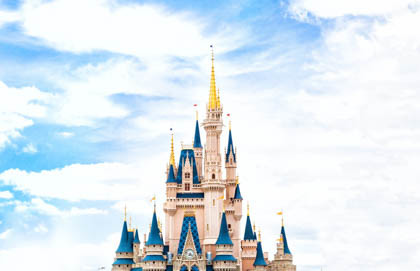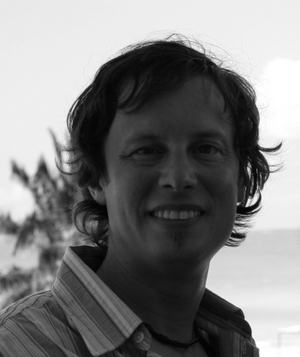Last summer, I visited Walt Disney World in Florida. Like millions of others from every tongue and tribe, I participated in what has become a central ritual of North American life. Disney World is one of the most visited places on the planet after Mecca and the Vatican, and so I might even venture to call my trip a pilgrimage. For many, this sojourn to the place where dreams come true, this essential rite of childhood, is more than a vacation. It is a glimpse of glory. If happiness is—as the United States Declaration of Independence argues—an inalienable right, then this place, with its grand claims of being the happiest place on earth, is a kind of American paradise, an Eden that invites visitors to suspend their world-weary cynicism and be reborn as a child.
Disney World, like its sister Disney parks around the world, is more than a theme park. As you walk down its grand rue, that artifice of an idyllic American village from an America that never was, you become participants in an elaborate drama. In this place there are no ordinary people picking up garbage and selling souvenirs. Everyone is a "cast member" and their job is to make the illusion of this Never-Never Land as convincing as possible. Main Street U.S.A., the gateway into the Magic Kingdom, conveys a mythic vision of a more innocent America. For many, this enchanted place is an opportunity to escape the fallen and dirty state of self and society by offering an idealized vision of American capitalism as perpetual celebration.
If cleanliness is next to godliness, as John Wesley once quipped, Disney World is surely the holiest place on earth. This rubbish-free world, filled with fireworks, parades and permanent smiles, might be thought of as the happy ending to the American story—where nostalgia, technology and optimism fuse together to remind us that "there's a great big beautiful tomorrow shining at the end of every day" (lyrics written for Disney's Carousel of Progress, considered Walt Disney's favourite attraction, still running at the Magic Kingdom in Disney World).
There is truth to the idea, so quotably put by Max Weber, that modernity is characterized by the progressive "disenchantment of the world," and in many ways, Disney World could be seen as a very modern place: monitored, maintained and controlled by technology. Science, we are told, for all its promises of a better "Tomorrowland," disenchants the world by making it a more predictable and thereby safer place. And, indeed, Disney World is an innocuous world. We know that the Pirates of the Caribbean are only animatronics and we know that the ghosts in the Haunted Mansion are only smoke and mirrors. Each thrill is limited with the tightest of liability clauses, and each cavalcade of spontaneity occurs on schedule. Because of this, it might be tempting to disregard Disney World as one more example of what the French sociologist Baudrillard referred to as a simulacrum—a kind of façade, willingly embraced, that replaces actual experience with a virtual experience that's protected and hermetically sealed.
But there is something more to Disney World. Alongside the modern notion of disenchantment is a powerful counter-tendency, a basic human need to be enchanted, to fill the vacuum left by old convictions, and to do so without invoking traditional belief systems. For many in the contemporary world, religion and the deep sense of mystery that accompanies it has been supplanted by rational explanations and secular institutions. But our need for stories and myths that satisfy a longing for other more magical worlds (a hankering once filled by the hope of paradise) remains strong. In this respect, Disney World is an opportunity for safetygated re-enchantment, a place where we are free to take a leap of faith (with just a pinch of pixie dust, of course) without rejecting the rationality that keeps us grounded (not to mention fiscally stable enough to afford the tickets that allow us in the park gates).
At the heart of Disney World, I would argue, is pseudo-religious mythos that borrows heavily from the Christian story. Like any good piece of theatre, Disney World has its share of villains and heroes bound together in a morality play that revolves around a messianic mouse. Perhaps this is most telling in the largest and most elaborate of Disney World's stories: the night time spectacle of "Fantasmic." Every night, about 10,000 spectators gather in the Hollywood Studio's amphitheatre to witness a grand ritual based on Mickey Mouse and his battle with the iniquitous powers of darkness. In an attempt to destroy the virtuous mouse, the evil queen Maleficent summons up all the demons that Hell has to offer, and Mickey must confront a giant serpent, an 18,000 pound dragon, and finally Satan himself (as envisioned in Fantasia's animated interpretation of Mussorgsky's Night on Bald Mountain). In this epic clash, natural gas pumped under the water surrounding the stage is ignited to create a literal lake of fire. With the power of goodness and wishes, Mickey casts the minions of Hell into the fiery abyss, douses the flames and establishes his reign over the good creatures of his kingdom, who process before him on floating barges. In the original version of this story, Mickey was supposed to confront Satan by walking across the water—a trick that had to be eliminated due to technical problems.
The Christian overtones of this spectacle are clear, and like the Christian stories from which they draw, these Disney stories are catalyzers of a community formed around a place that Umberto Eco describes as America's Sistine Chapel. In these stories, goodness (beautiful and fuzzy) is always rewarded; and evil (apparent and black-hatted) is always punished. It is a simple formula played out time and again, generation after generation, in a culture that longs for common stories to help us shape our identity and bind us together as a community. In a world where the deeper stories have been forgotten, these stories are one of the richest communal bonds we have to transcend the mundane.
Beyond the crass commercialism and kitsch, there is something profound about our desire for enchantment and the desire to pass these enchanted experiences on to our children. In our rapidly changing world, Disney World promises consistency and stability—a ritualistic space that remains impervious to the jadedness of the age.
There is a story that John Findlay tells of a conversation between a young Billy Graham and Walt Disney in his newly opened Disneyland in California. After spending a day touring the park, the Reverend Graham sat on a bench with Disney. "Walt," Graham offered, "you have a great fantasy land here."
"You preachers have it wrong," Disney corrected him. "The fantasy isn't here. This is very real; the park is realitiy."
In many ways, Disney was right. Disney World has very much manipulated the perspective from which we imagine our culture, our landscape and our dreams. Walt recognized that popular culture is a powerful storyteller, and these stories can play an influential spiritual role in shaping our sense of what is real and what is illusion. To put it another way, it frames the imaginative horizons of our hope. For many, an old Hank Williams Jr. redneck anthem could be rephrased: because if Heaven ain't a lot like Disney, then we don't want to go.
But if the apparently timeless appeal of Disney World is symptomatic of the spiritual malaise of contemporary culture, it is also an important indicator of its spiritual hunger. Disillusioned by the lies of our culture, millions choose to escape to a kinder and more magical facsimile of hope at Disney. As C.S. Lewis once observed, the potency of fantasylands are their ability to break the "evil enchantment of worldliness" and arouse a dim longing in us for something unreachable within the drab flatness of wanton perception. Millions visit Disney World for a chance to walk through the looking glass, to be transported to another, more whimsical world where our imaginations take flight. While the happiness it offers is ephemeral, the profound feeling of disenchantment that draws visitors to momentarily withdraw is not.





